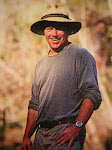On the bank of Hontoon Island under a spreading live oak tree stands a simple totem pole carved in the shape of an owl.* Its wooden eyes stare at the river with an air of wisdom far beyond what we normally expect of a log. Calm and indifferent, they hint at many closely-held secrets—and all the answers.
| Eyes with wisdom we rarely expect of a log |
Archaeologists have looked to the Hontoon Owl for answers. Why, for instance, did the Timucuans carve it and place it on this prominent spot on the river bank nearly five hundred years ago? What message was it meant to convey? They know that some cultures considered owls to be good omens while others thought they were harbingers of evil. Not much help there. For now, it seems the best place to look for clues to the Hontoon Owl‘s message might not be in the owl’s vacant eyes but in our own quirky psyche.
Deep in the dark, gooshy recesses of the human brain there’s something—a synapse? a cluster of cells? a parasitic worm with an odd sense of humor?—that compels us to tell the world, "I was here!" Think back to your own childhood and every time you saw workers pouring cement for a sidewalk. If you were like most kids, you immediately calculated the best time to return and convert the walkway to a monument to yourself. With the speed of the prodigy your parents hoped you would be, you feverishly calculated (in your head) when the workers would be leaving and what time it would get dark enough to cover your deed. You then overlaid this data (still in your head) onto your best calculations of how long it takes cement to harden, and concocted your evil plan. For most of us, the prospect of our pending immortalization was thrilling beyond words. It’s an instinctive thrill we seem to never outgrow. The conquerors of the New World based dark careers on it.
When Ponce de Leon staked his claim to Florida, on his second landing on the southeast coast, he placed an inscribed stone monument on the bank of a stream. The stone was never seen again and no record was made of the message inscribed on its face. And yet, though it was written in an unknown language by people of a foreign culture, the Indians could as easily guess what it said as we can.
Half a century later, when French explorer Jean Ribault came to Florida, he brought items absolutely necessary for claiming new lands; a boat-load of settlers and five stone columns to be used as territory markers. As he worked his way up the coast looking for sites to build a fort, Ribault erected columns on prominent banks of rivers found to have good harbors and good lands.
| Chief Athore shows Laudonniere the stone column left by Ribault (From a painting by Jacques Le Moyne) |
When fellow explorer Rene de Laudonniere arrived at St. Johns River a year later, in 1564, he found that the Indians had adorned Ribault’s column near Ft. Caroline with flowers and nature objects. It had become an object of worship. It’s a safe bet he was surprised by the Indian’s reverence for the column; probably even pleased. But, the column’s message was not meant for the Indians. It was for any Spaniards or other European’s that passed that way. When the Spanish learned of the columns, they got the message loud and clear and promptly sent an expedition to find and remove them.
Humans aren’t the only animals that leave calling cards. For most species it’s a matter of survival, either for the individual or their species. Some do it to define their territory. Bears will stand and claw the trunk of a tree to tell trespassers, "this is my property, keep out!" Sometimes they‘ll claw as high on the trunk as they can reach, a subtle footnote reading, "…Oh yeah, and I’m this tall."
Some animal’s boundary markers are more subtle. One day, while paddling Chassahowitzka River, I noticed something moving in a clearing near the river bank. As I eased closer, I could see an otter rolling excitedly on the ground and rubbing its body against trees and shrubs. It was totally enraptured, like a cat in catnip. I later learned from a trapper that this was a "scent post," where neighboring otters smear pheromone-ladened musk to define the boundary between their territories.
On a recent paddle around Hontoon Island, as I passed the Hontoon Owl it occurred to me that the need to stake claims is still alive and well in our own society. Some of us spray-paint "tags" on subway walls the way small dogs pee on shoes. Others build tall buildings and name them after themselves, the way big dogs pee on little dogs.
As I paddled away, I glanced back at the owl one last time before rounding the point—as if something might have changed. Nothing. It just stood there like a monk, contemplating the river and minding its own business. Maybe its message is more obvious that we think.
* This is actually a replica of the owl totem—the original effigy carving is in Ft. Caroline Museum near Jacksonville.
*

No comments:
Post a Comment